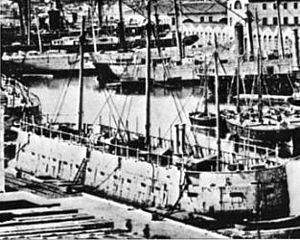Namesake Lava Laid down 20 August 1854 Maiden voyage 6 August 1855 Launched 5 June 1855 Weight 574 tons Draft 2.66 m | Ordered July 1854 Decommissioned 1871 Construction started 20 August 1854 Length 53 m Displacement 574,000 kg Builder Lorient | |
 | ||
Cost 1.23 million French Francs | ||
French ironclad lave
Lave was an ironclad floating battery of the French Navy during the 19th century. She was part of the Dévastation-class of floating batteries.
In the 1850s, the British and French navies deployed iron-armoured floating batteries as a supplement to the wooden steam battlefleet in the Crimean War. The role of the battery was to assist unarmoured mortar and gunboats bombarding shore fortifications. The French used three of their ironclad batteries (Lave, Tonnante, and Dévastation) in 1855 against the defences at the Battle of Kinburn (1855) on the Black Sea, where they were effective against Russian shore defences. They would later be used again during the Italian war in the Adriatic in 1859.
The ships were flat-bottomed, and commonly nicknamed "soapboxes". They were towed from France to Crimea to participate in the conflict. Lave was towed by the paddle frigate Magellan.
